Firmware Status Check Was Aborted Internally. Please Try Again.
Contents
- Entrada Timing
- Pilot Campaigns
- Verbose Logging
- Campaign Lifecycle Flow for v1
- Campaign Lifecycle Flow for v2
Entrada times
Entrada times vary depending on whether they are scheduled on OMA-DM and LWM2M FOTA devices versus HTTP FOTA devices.
Campaign times for OMA-DM and LWM2M FOTA devices
Devices using LWM2M or OMA-DM for device management answer to "button" messages to get-go a entrada.
The ThingSpace campaign API allows the user to schedule an "on-demand" update or a twenty-four hour period in the future. On-demand updates usually occur within 2 hours once they are scheduled, to permit all the pre-validation checks to occur. An case schedule for an OMA-DM or LWMM2M on-need campaign is shown in the following image:
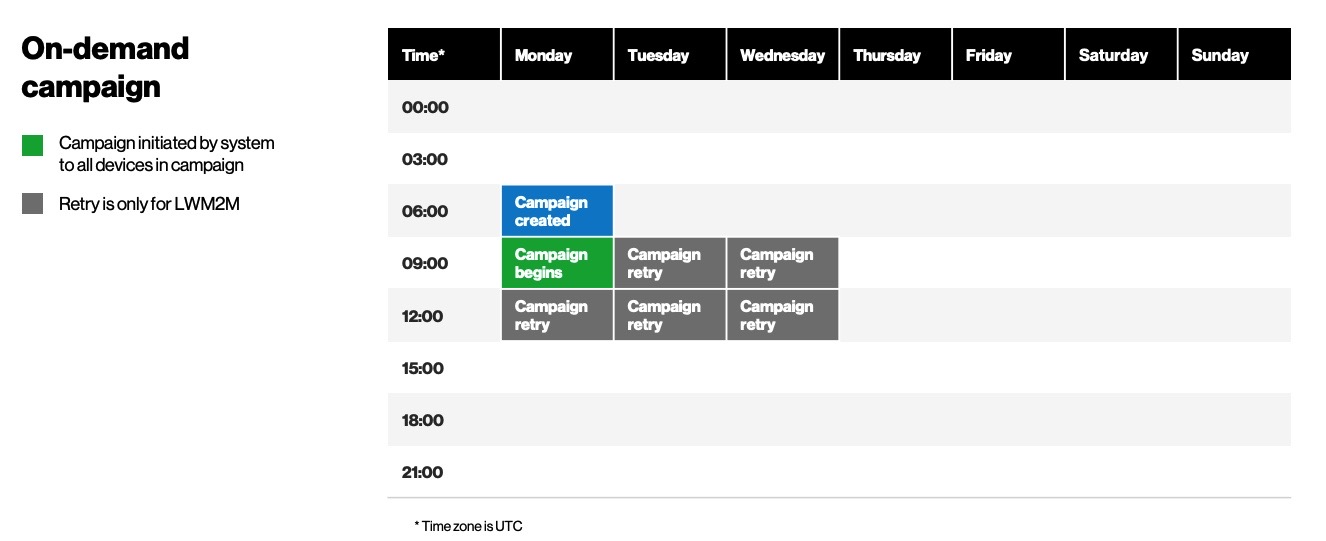
Updates in the future normally begin around 12:00 AM UTC. For LWM2M devices, if the device does not reply, the system tries again effectually iv:00 AM UTC, and repeats this for up to 3 days. An example schedule for an OMA-DM or LWM2M future campaign is shown in the following image:
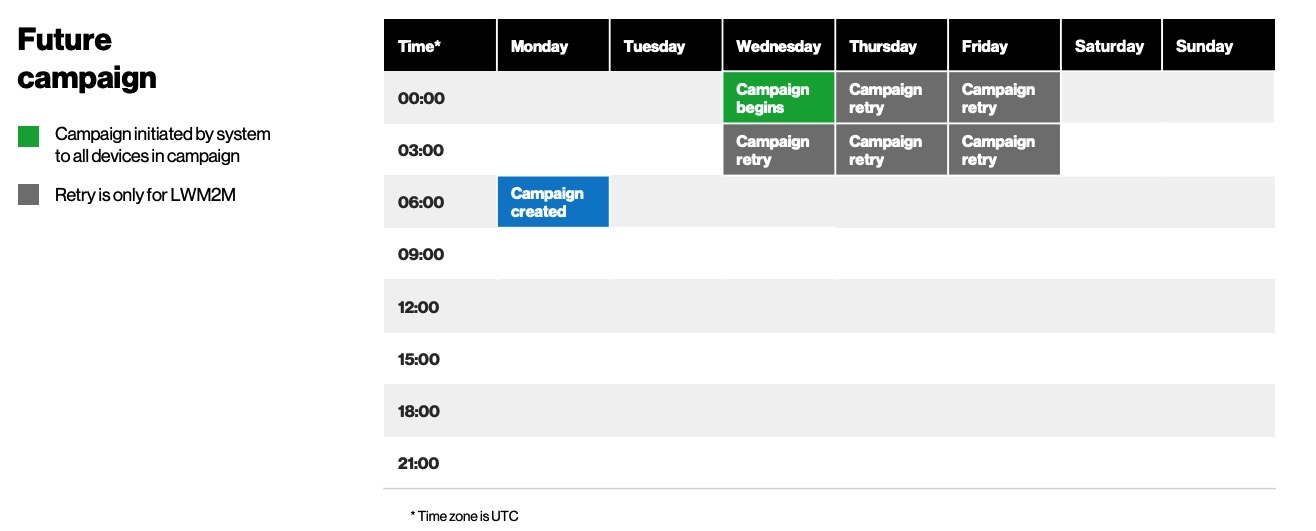
These devices follow the LWM2M and OMA-DM standard so these devices volition respond to a push message with a response that the device has started, and eventually completed, the update. The Open Mobile Alliance has a well-documented FOTA state machine for the firmware update process.
Campaign time windows for HTTP FOTA devices
Devices using HTTP(South) for FOTA device management do not respond to "push" letters to first a campaign, but rather, devices bank check-in during periodic intervals as specified by the device OEM. To suit a campaign with variable get-go times, the Schedule Campaign API requires a outset and end date. For example, the start date could be on a Sun at 12:00 AM UTC and the end date could exist on a Saturday at 11:59:59 PM UTC. When the device checks-in during that window, it volition download and apply any new eligible firmware/software updates bachelor.
An example on-demand campaign schedule for HTTP devices is shown below:
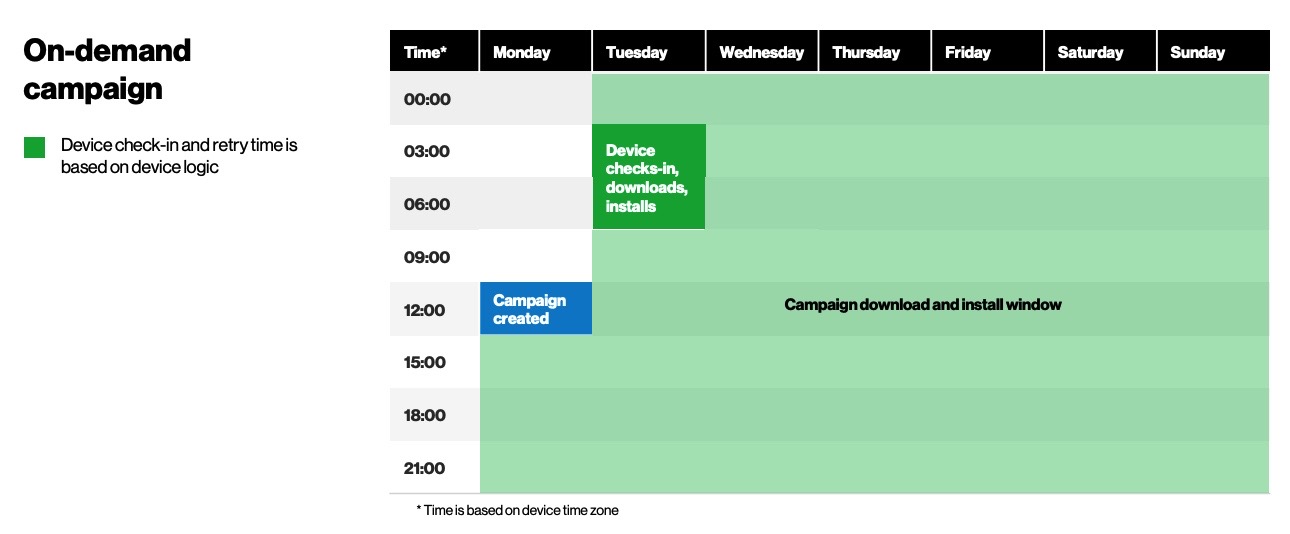
A set of optional parameters allow you to specify more than discrete times within the get-go and end dates in the event that the device should only receive the update during those times. For example, if the device is a smart low-cal that should not be updated during the evening, a time window can specify not but that the campaign runs from Sunday-Saturday, merely that information technology must only happen during the late morning hours.
The Schedule Campaign API as well offers an optional parameter that allows you lot to specify a detached time window when the device should download the update, and a different time window when the device should apply the update.
A campaign schedule for a future campaign with detached time windows is shown beneath.
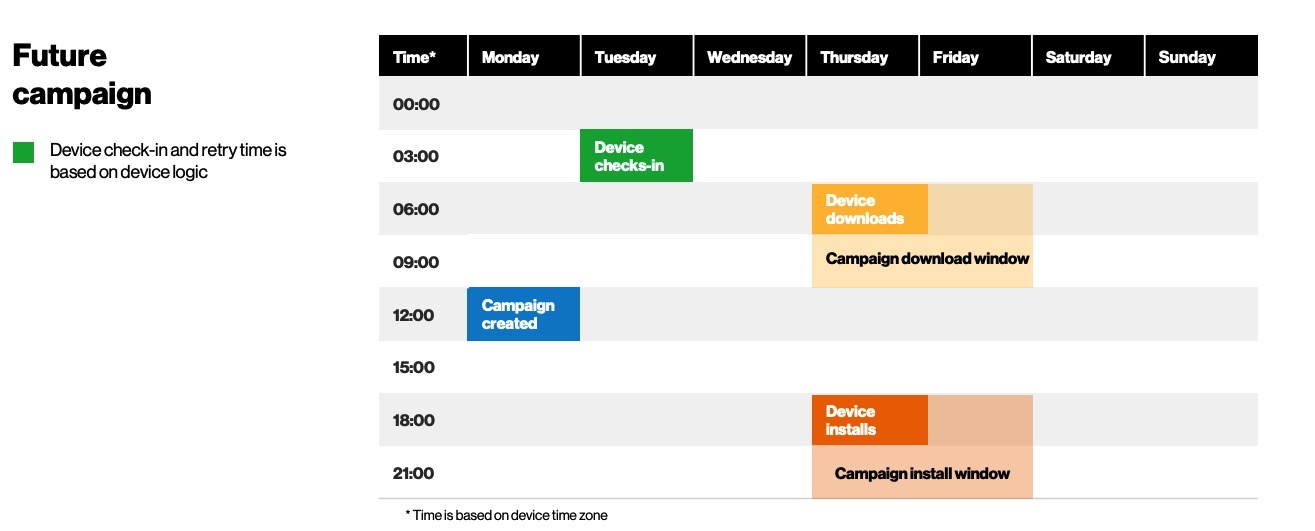
Pilot campaigns for HTTP FOTA devices
For devices using HTTP for FOTA, the Schedule Campaign API now has a built-in requirement that a "pilot entrada" must be run with that firmware/software before a large scale campaign can run. The purpose of the pilot campaigns is to test a small number of devices to ensure that in that location are no unexpected delivery or compatibility problems with that firmware/software. The pilot campaign limit is in identify until at least 5 devices and no more than 20 devices take had at least a l% success charge per unit. Users can run equally many up to 20 device pilot campaigns equally necessary; once the fifty% success rate has been accomplished, the 20 device limit will be lifted.
Verbose Logging for HTTP FOTA devices
If pilot campaigns are not successful, developers have the selection to enable and fetch logs for up to 20 devices. Developers initially need to enable logging with the Verbose Logging API. Logging turns off automatically after vii days to avoid unnecessary device resource usage. When the device checks in after that setting is enabled, the device starts collecting logs. The device periodically uploads those logs to ThingSpace and purges them from the device. Later at to the lowest degree 24 hours, the programmer can call the Verbose Logging API again to fetch the logs for analysis or can view the check-in history as reported by the FOTA server. After 30 days, the logs are purged from ThingSpace.
Campaign Lifecycle Menses for OMA-DM or LWM2M Devices using the /v1 Resource Path

- The campaign always starts with a user scheduling the entrada with proper make, model, and current software prerequisites to exist updated and identifying the software to be updated and when.
- Afterward the user sends the campaign request, the campaign changes to "Asking Pending" status.
- Later passing parameter checks, the entrada status moves to "Queued".
Parameter checks could include things like FOTA eligibility, unknown customer type, make, model, firmware, and determining if the device is in another campaign. - If parameter checks fail, it moves to "RequestFailed."
- Later passing parameter checks, the entrada status moves to "Queued".
- The campaign stays in "Queued" condition while the systems collect requests.
- Unremarkably the campaign would move to "in progress." This stage is is when the software updates are executed in the OMA-DM or LWM2M server.
- User tin choose to abolish the entrada before the commencement date, or they tin can remove all devices from the queued campaign.
- Subsequently the campaign starts, information technology is "in progress" during the device update.
- Once the campaign stop date has been reached, the entrada status moves to "Finished."
- If the OMA-DM or LWM2M server schedule a campaign, it moves to "UpgradeFailed" status.
Device Lifecycle Catamenia for OMA-DM or LWM2M Devices using the /v1 Resource Path
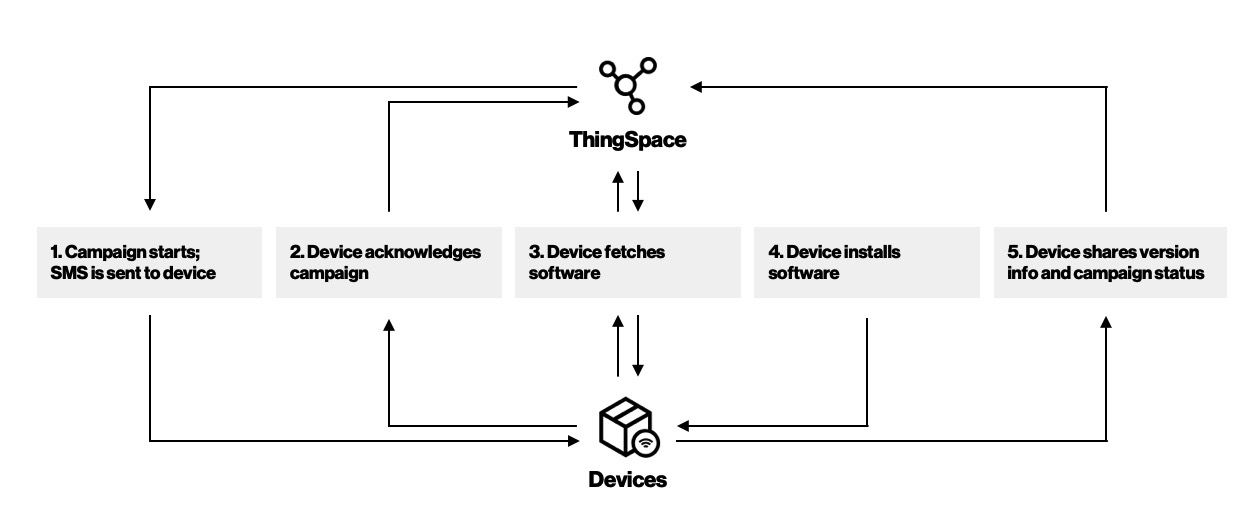
Condition and Error Messages for OMA-DM ro LWM2M Devices using the /v1 Resource Pat
| Device Status | Device Detail Status |
|---|---|
| Device Accepted | Device cleared all cheque so it can be added to the scheduled listing. |
| Device Rejected | Device not found. |
| Device Rejected | Invalid Device IMEI. |
| Device Rejected | Device not eligible for service. |
| Device Rejected | Unknown customer device blazon. |
| LicenseRemoveFailed | License removal not allowed for devices that have ever upgraded firmware. |
| LicenseRemoveFailed | Internal fault. |
| Device Rejected | Device scheduled for firmware-upgrade previously, it needs to exist completed earlier another upgrade is schedule. |
| Device Rejected | Device make/model exercise non meet firmware prerequisites. |
| Device Rejected | Current device firmeware version does non come across firmware prerequisites. |
| Upgrade Failed | Device is non in an active state or is not continued. |
| Upgrade Failed | Current device module does non meet firmware prerequisites. |
| Upgrade Failed | Firmware update to device failed. |
| Upgrade Failed | Internal System Error. Please retry upgrade. |
| Upgrade Success | The firmware upgrade was successful. |
Campaign Lifecycle Menses for HTTP Devices using the /v2 Resources Path

- Creating a campaign starts with the user scheduling which devices with proper brand, model and current software prerequisites demand to exist updated with which software at what date.
- In one case the user schedules a entrada request, the campaign changes to "Request Awaiting" status
- After passing parameter checks, entrada status typically moves to "Queued" status.
- If parameter checks neglect, it moves to "RequestFailed" and may bypass "Pending."
Checks could include eligibility such every bit licenses, FOTA capable, prerequisistes or timing checks. - If information technology is an on-demand entrada, it bypasses the "Queued" condition and moves to "Scheduled."
- The campaign usually stays in "Queued" status while the system collects requests.
- Once the start engagement has begun, it moves to "Scheduled."
- The user can choose to abolish the campaign in "Queued" status.
- The campaign stays in "In Progress" during the device update.
- One time the campaign cease date has been reached or if all devices were successfully upgraded, it moves to "concluded." For an on-need campaign, the end date is one week later the start appointment.
- After the campaign begins but before it ends, the user could make up one's mind to "abort" the campaign. Some devices may have already been upgraded.
Device Lifecycle Menses for HTTP Devices using the /v2 Resource Path

Status and Error Messages for HTTP Devices using the /v2 Resource Path
| Device Status | Device Detail Condition |
|---|---|
| Accepted | Device cleared all checks and so it tin can be added to the scheduled list. |
| DeviceRejected | Device not institute. |
| DeviceRejected | Device scheduled for firmware upgrade previously, needs to be completed before another upgrade is scheduled. |
| DeviceRejected | Device not eligible for service (not FOTA capable) |
| DeviceRejected | Invalid device IMEI. |
| DeviceRejected | Current device software version does not meet software prerequisites. |
| DeviceRejected | Device make/model does not meet softwware prerequisites. |
| DeviceRejected | Device is not in active land or is not connected. |
| DeviceRejected | Internal Error. |
| UpgradedFailed for UpgradePending | RovaClientDidNotReportStatus |
| UpgradedFailed for UpgradePending | RovaClientDownloadFailed |
| UpgradedFailed for UpgradePending | RovaClientDownloadNotInstalledYet |
| UpgradedFailed for UpgradePending | RovaClientDownloadedInstallFailed |
| UpgradedFailed for UpgradePending | Uknown device error. |
| UpgradedFailed for UpgradePending | Other. |
| CampaignCancelled | Campaign canceled by user. |
| UpgradeSuccess | Download and install succeeded. |
| CampaignAborted | Campaign aborted past user. |
nakamuraroyhorder.blogspot.com
Source: https://thingspace.verizon.com/documentation/apis/software-management/getting-started/about_campaigns.html
0 Response to "Firmware Status Check Was Aborted Internally. Please Try Again."
Post a Comment